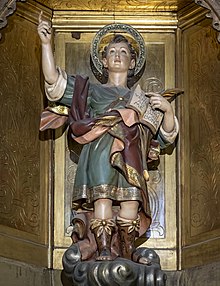Pancras of Rome | |
|---|---|
 The Cathedral of the Holy Cross and Saint Eulalia in Barcelona | |
| Martyr | |
| Born | c. 289 Synnada in Phrygia (modern-day Şuhut, Afyonkarahisar, Turkey) |
| Died | 12 May 303 or 304 (aged 14) Rome |
| Venerated in | |
| Major shrine | San Pancrazio, Rome, Italy. |
| Feast | 12 May |
| Attributes | Roman legion armour, martyr's palm branch, book, quill, sword |
Pancras (Latin: Sanctus Pancratius) was a Roman citizen who converted to Christianity and was beheaded for his faith at the age of fourteen, around the year 304. His name is Greek (Πανκράτιος Pankrátios), meaning 'all-powerful'.
From an early period, Pancras was venerated together with Nereus and Achilleus in a shared feast day and Mass formula on 12 May. In 1595, 25 years after Pope Pius V promulgated the Tridentine Missal, Domitilla was also added.
Since 1969, Pancras has been venerated separately, still on 12 May. He is traditionally the second of the Ice Saints.[1] In the Syriac traditions he is known as Mor Izozoel (Mar Azazael), remembered on 12 May and 12 August. He is the patron saint of children.
The London district of St Pancras, and by extension, the railway station of the same name, is named after St Pancras Old Church and St Pancras New Church.